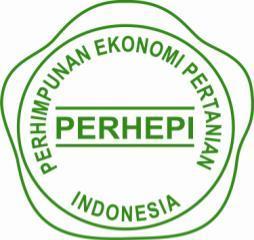Hubungan Mikroklimat terhadap Populasi Sapi Perah Friesian Holstein di BPTSP HPT Cikole Lembang
The Correlation of Microclimate on Population of Friesian Holstein Dairy Cattle at BPTSP HPT Cikole Lembang
DOI:
https://doi.org/10.51852/jaa.v6i2.545Keywords:
friesian holstein, microclimate, populationAbstract
The purpose of this study was to determine the correlation between microclimates in FH dairy cattle at BPTSP HPT Cikole. The main material in this study was data on the population of Friesian Holstein (FH) dairy cattle of 111 heads raised from 2017 to 2019. Additional data used in this study are temperature, humidity, precipitation, and temperature humidity index from January 2017 to December 2019. The data processed into parameters included livestock populations affected by microclimate. Data processing methods used descriptive analysis, regression, and correlation. The total population in ST from 2017 to 2019 was different. In 2018 the population increased from the previous year, but in 2019 the population decreased. Based on regression and correlation analysis, there was a noticeable influence between humidity and precipitation on the FH cattle population with R2 values of 33.36% and R2 of 40.28%. It can be concluded that there was no significance correlation between microclimate and cow physiological condition. Therefore, the microclimates consisting of temperature, humidity, precipitation, and THI gave no effect on the Friesian Holstein cattle physiological conditions.
References
Adinata Y, Sumadi, Adiarto. Sebaran populasi sapi friesian holstein di beberapa kabupaten provinsi jawa tengah dan daerah istimewa yogyakarta. Buletin Peternakan. 33(3): 129–142.
Astuti CC. 2017. Analisis korelasi untuk mengetahui keeratan hubungan antara keaktifan mahasiswa dengan hasil belajar aktif. Journal Information and Computer Technology Education. 1(1): 1–7.
Berman A. 2005. Estimates of heat stress relief needs for holstein dairy cows. Journal Animal Science. 83: 137–145.
[BPS] Badan Pusat Statistik. 2019. Statistik Indonesia 2019. Jakarta (ID): Badan Pusat Statistik.
Bulitta FS, Aradom S, Gebresember G. 2015. Effect of transport time of up to 12 hours on welfare of cows and bulls. Journal of Service Science and Management. 8(2): 161–182.
[Ditjen PKH] Direktorat Jenderal Peternakan dan Kesehatan Hewan. 2018. Statistik Peternakan dan Kesehatan Hewan 2018. Jakarta (ID): Direktorat Jenderal Peternakan dan Kesehatan Hewan Kementerian Pertanian RI.
Firman S, Prayoga SBK, Hermawan. 2010. Peran usaha perbibitan dalam pengembangan ternak sapi perah di Indonesia. Jurnal Ilmu Ternak. 10(1): 7–13.
Heraini D, Purwanto BP, Surhayadi. 2019. Perbandingan suhu lingkungan dan pengaruh pakan terhadap produktivitas sapi perah di daerah dengan ketinggian berbeda. Jurnal Ilmiah Peternakan Terpadu. 7(2): 234–240.
Hijriani A, Muludi K, Andini EA. 2016. Implementasi metode regresi linier sederhana pada penyajian hasil prediksi pemakaian air bersih PDAM way rilau kota Bandar Lampung dengan sistem informasi geografis. Jurnal Informatika Mulawarman. 11(2): 37–42.
Hoards WD. 2006. Dairy Cattle Fertility and Sterility. Amerika Serikat: WD Hoards and Sons Company
Khotimah K. 2011. Identifikasi populasi dan kualitas susu sapi perah pada anggota kube psp maju mapan desa kemiri kecamatan jabung kabupaten malang. 2011. GAMMA. 7(1): 32–38.
Latipah I, Rahayu S, Firmansyah C. 2015. Analisis pembiayaan pengadaan calon induk sapi perah antar wilayah sentra pengembangan sapi perah. Students e–journals. 4(2): 1–8.
Leksono AS. 2007. Ekologi Pendekatan Deskriptif dan Kuantitatif. Malang (ID): Banyumedia.
Muthalib, RA. 2015. Pengaruh musim kawin terhadap produktivitas induk kambing PE pada kondisi pedesaan. Jurnal Ilmu–Ilmu Peternakan. 18(1): 36–42.
Novianti J, Purwanto BP, Atabany A. 2013. Respon fisiologis dan produksi susu sapi perah FH pada pemberian rumput gajah (Pennisetum purpureum) dengan ukuran pemotongan yang berbeda. Jurnal Ilmu Produksi dan Teknologi Peternakan. 1(3): 138–146.
Rahardja DP. 2007. Ilmu Lingkungan Ternak. Makassar (ID): Masagena.
Ratnasari D, Atabany A, Purwanto BP, Salma LB. 2019. Model pertumbuhan sapi perah friesian holstein (fh) dari lahir sampai beranak pertama di BBPTU–HPT sapi perah menggunakan model matematic logistic. Jurnal Ilmu
Produksi dan Teknologi Hasil Peternakan. 07(1): 18–21.
Rotter R, Van De Geijn SC. 1999. Climate change effect on plant growth, crop yield and livestock. Climatic Change. 43(4): 651–681.
Suherman D, Purwanto BP, Manalu W, Permana IG. 2013. Model penentuan suhu kritis pada sapi perah berdasarkan kemampuan produksi dan manajemen pakan. Jurnal Sains Peternakan Indonesia. 8(2): 121–139.
Yani A, Purwanto BP. 2006. Pengaruh iklim mikro terhadap respons fisiologis sapi peranakan fries holland dan modifikasi lingkungan untuk meningkatkan produktivitasnya. (Ulasan). Jurnal Media Peternakan. 29(1): 35–46.


1.png)









